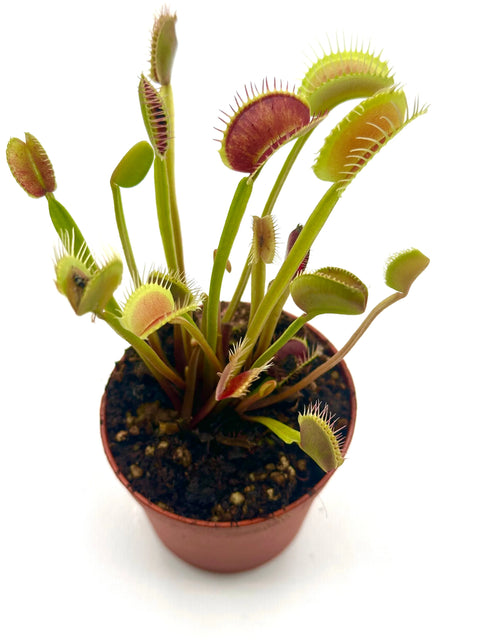
Dionaea Muscipula "Classic"
Free shipping on orders over €29.99
Beautiful things need a little magic (and patience!) ✨
Our plants are prepared for their journey with lots of love, quick pampering, and special protection. Therefore, we take 2 to 5 business days to prepare them as best as possible.
But don't worry! Once ready, the BRT courier is there like lightning: in 24/48 hours your plant will be at your home, ready to bring a little greenery into your life! 🌿🚚💚
Dionaea Muscipula , commonly known as Venus flytrap , is a truly fascinating and unique carnivorous plant.
Main features:
- Snap traps: The most distinctive feature of Dionaea is its modified leaves, called snap traps. These traps consist of two serrated lobes that quickly close when an insect lands on them, trapping it inside.
- Stimulation: Traps close only if stimulated repeatedly or at specific points, thus avoiding wasting energy on false alarms.
- Digestive: Once the insect is captured, the plant secretes digestive enzymes that break down the animal's soft parts, absorbing its nutrients.
- Origins: Dionaea muscipula is native to the wetlands of North and South Carolina, United States.
- Appearance: In addition to the traps, the plant also produces white flowers, which bloom on long stems to prevent pollinators from being accidentally captured.
Why is it so fascinating?
- Capture mechanism: The way the traps close is a true spectacle of nature, attracting the curiosity of adults and children alike.
- Adaptation to the environment: Dionaea muscipula has developed this capture mechanism to compensate for the lack of nutrients in the soil in which it grows.
- "Active" plant: Unlike many other plants, Dionaea muscipula appears almost "alive" thanks to its rapid movements.
Where does he live?
Dionaea muscipula is native to the wetlands of North and South Carolina in the United States . More specifically, its natural habitat is peat bogs and marshy areas, where the soil is poor in nutrients.
Characteristics
Imagine two modified leaves, joined along a central vein, opening like the pages of a book. Inside these "pages" are highly sensitive hairs called trichomes. These hairs act as sensors and, when touched by an insect, trigger a mechanism that closes the trap.
Identity card
Dionaea Muscipula "Classic"
This plant seeks a very bright environment all year round, seeking shade during the hottest hours of the summer months.

Constant water in the saucer 2/3 cm, IMPORTANT always use distilled water.

Dionaea muscipula (Venus flytrap) originates from peat bogs in North America, so it thrives in a temperate climate with warm summers and cold winters. This plant is accustomed to living chastely outdoors from spring onwards until October. Dionaea muscipula will experience vigorous growth and then decline in winter, but don't worry, it's normal!

Dionaea Muscipula, accustomed to living in the peat bogs of North America, therefore needs a substrate that is half acidic sphagnum peat and half perlite.
Trying to change the substrate every year.





Level of commitment
Dionaea Muscipula "Classic"
Suitable for everyone, don't worry, I'll survive even in the house of a black thumb



